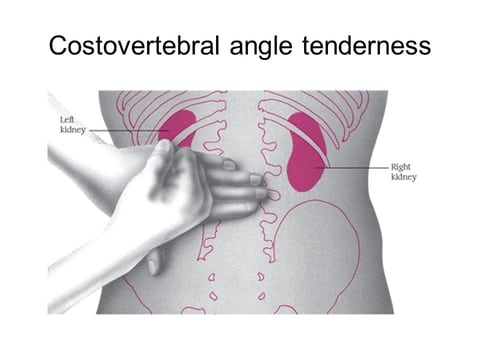Costovertebral Angle Tenderness
Introduction
Costovertebral angle tenderness (CVAT) refers to the pain or tenderness experienced in the region between the ribs and the spine, known as the costovertebral angle. It is an important clinical finding that can provide crucial insights into the underlying conditions affecting the kidneys, urinary system, or adjacent structures. Understanding the causes, symptoms, and management of CVAT is essential for healthcare professionals to accurately diagnose and treat the underlying conditions. In this article, we will delve into the details of CVAT, exploring its potential causes and providing insights into its diagnosis and management.
Causes of Costovertebral Angle Tenderness:
- Renal Conditions: The most common cause of CVAT is kidney-related conditions. Kidney infections, such as pyelonephritis or urinary tract infections (UTIs), often result in inflammation and irritation around the kidneys, leading to tenderness in the costovertebral angle.
- Renal Calculi: Kidney stones can also cause CVAT when they obstruct the flow of urine or irritate the urinary tract. The pain can be excruciating and radiate from the back to the groin area.
- Musculoskeletal Conditions: Musculoskeletal causes, such as muscle strains, sprains, or injuries to the ribs or spinal column, can also result in CVAT. These conditions can be triggered by trauma, poor posture, or overuse of muscles in the area.
- Inflammatory Conditions: Certain systemic conditions, such as rheumatoid arthritis, ankylosing spondylitis, or reactive arthritis, can cause inflammation around the costovertebral angle, leading to tenderness.
Symptoms of Costovertebral Angle Tenderness:
The primary symptom of costovertebral angle tenderness is pain or tenderness in the upper back, specifically in the area where the lower ribs join the spine. The pain can be unilateral or bilateral and may vary in intensity. Other associated symptoms may include:
- Pain and Tenderness: The hallmark symptom of CVAT is pain or tenderness experienced in the costovertebral angle area. The intensity of pain can range from mild discomfort to severe, depending on the underlying cause.
- Fever and Chills: In cases where CVAT is caused by a kidney infection, patients may experience fever, chills, and an overall sense of malaise.
- Urinary Symptoms: If CVAT is related to kidney stones or urinary tract issues, additional symptoms may include frequent urination, urgency, pain or burning during urination, and blood in the urine.
Causes:
Costovertebral angle tenderness is typically associated with conditions affecting the kidneys or adjacent structures. The most common causes include:
- Kidney infection (pyelonephritis): This is a bacterial infection that affects one or both kidneys. It commonly occurs as a result of a urinary tract infection (UTI) that spreads to the kidneys. Pyelonephritis can cause inflammation and pain in the costovertebral angle.
- Kidney stones: These are hard deposits that form in the kidneys and can cause significant pain when they pass through the urinary tract. The movement of kidney stones can lead to CVA tenderness.
- Renal abscess: A collection of pus within the kidney, usually caused by a bacterial infection, can result in CVA tenderness.
- Renal infarction: A blockage in the blood vessels that supply the kidneys can cause tissue damage and pain in the costovertebral angle.
- Other causes: Less common causes of CVA tenderness include trauma to the area, spinal conditions, or referred pain from other organs such as the liver or pancreas.
Diagnosis:
When a patient presents with CVAT, the healthcare provider will perform a thorough physical examination and medical history assessment. Diagnostic tests may include:
- Urine Analysis: A urinalysis can help identify the presence of infection, blood, or abnormal levels of certain substances that may indicate underlying kidney-related issues.
- Imaging Studies: Imaging techniques such as ultrasound, CT scan, or MRI may be utilized to visualize the kidneys, urinary tract, or adjacent structures, helping to identify stones, infections, or other abnormalities.
Treatment of CVA Tenderness
The treatment of costovertebral angle tenderness depends on the underlying cause. It is crucial to identify and address the specific condition to alleviate symptoms and prevent complications. The following treatment approaches may be employed:
- Antibiotics: If the cause of CVA tenderness is a kidney infection, bacterial infection, or abscess, antibiotic therapy is the primary course of treatment. The choice of antibiotics will depend on the causative bacteria and the severity of the infection.
- Pain management: Over-the-counter pain relievers such as nonsteroidal anti-inflammatory drugs (NSAIDs) can help reduce pain and inflammation associated with CVA tenderness. In more severe cases, prescription pain medications may be necessary.
- Fluid intake and dietary modifications: Increasing fluid intake and making dietary changes, such as avoiding certain foods that contribute to kidney stone formation, can be beneficial in managing CVA tenderness caused by kidney stones.
- Surgical intervention: In cases where kidney stones are too large to pass naturally or if there are complications, surgical intervention may be required. The specific procedure will depend on the size, location, and characteristics of the kidney stones.
- Treating underlying conditions: For individuals with underlying medical conditions such as spinal issues or referred pain from other organs
- Physical Therapy: For musculoskeletal causes, physical therapy, including exercises and techniques to improve posture, can help alleviate CVAT symptoms.
Conclusion
Costovertebral angle tenderness can be a crucial clinical finding in diagnosing and managing various conditions affecting the kidneys, urinary system, or adjacent structures. Identifying the underlying cause of CVAT is essential for appropriate treatment and ensuring the well-being of the patient. Healthcare professionals play a critical role in assessing symptoms, conducting diagnostic tests, and tailoring management strategies to address the specific cause of CVAT. By understanding the causes, symptoms, and management options, healthcare providers can effectively address CVAT and improve patient outcomes.
